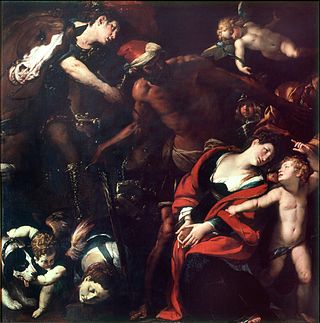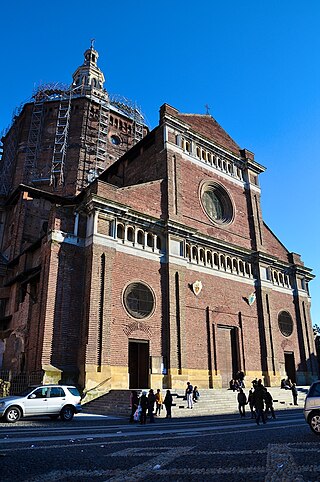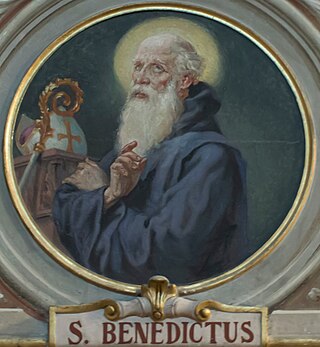Related Research Articles

Pavia is a town and comune of south-western Lombardy, in Northern Italy, 35 kilometres south of Milan on the lower Ticino near its confluence with the Po. It has a population of c. 73,086. The city was the capital of the Ostrogothic Kingdom from 540 to 553, of the Kingdom of the Lombards from 572 to 774, of the Kingdom of Italy from 774 to 1024 and seat of the Visconti court from 1365 to 1413.
Pope Hormisdas was the bishop of Rome from 20 July 514 to his death. His papacy was dominated by the Acacian schism, started in 484 by Acacius of Constantinople's efforts to placate the Monophysites. His efforts to resolve this schism were successful, and on 28 March 519, the reunion between Constantinople and Rome was ratified in the cathedral of Constantinople before a large crowd.
Saint Jerome is a Christian church father, best known for translating the Bible into Latin.

Charles Borromeo was the Archbishop of Milan from 1564 to 1584 and a cardinal of the Catholic Church. He was a leading figure of the Counter-Reformation combat against the Protestant Reformation together with Ignatius of Loyola and Philip Neri. In that role he was responsible for significant reforms in the Catholic Church, including the founding of seminaries for the education of priests. He is honoured as a saint by the Catholic Church, with a feast day on 4 November.
Magnus Felix Ennodius was Bishop of Pavia in 514, and a Latin rhetorician and poet.

San Pietro in Vincoli is a Roman Catholic titular church and minor basilica in Rome, Italy, best known for being the home of Michelangelo's statue of Moses, part of the tomb of Pope Julius II. The Titulus S. Petri ad vincula was assigned on 20 November 2010, to Donald Wuerl. The previous Cardinal Priest of the basilica was Pío Laghi, who died on 11 January 2009.

The Holy Family consists of the Child Jesus, the Virgin Mary and Saint Joseph. The subject became popular in art from the 1490s on, but veneration of the Holy Family was formally begun in the 17th century by Saint François de Laval, the first bishop of New France, who founded a confraternity.

January 29 - Eastern Orthodox liturgical calendar - January 31

Rufina and Secunda were Roman virgin-martyrs and Christian saints. Their feast day is celebrated on 10 July.

Saint Marcian of Tortona is a saint of Roman Catholic church. He is traditionally said to have been the first bishop of Tortona, in what is now north-western Italy, a post he held for forty-five years.

The Diocese of Pavia is a see of the Catholic Church in Italy. It has been a suffragan of the Archdiocese of Milan only since 1817. Previous to the reorganization of the hierarchy in northern Italy by Pope Pius VII after the expulsion of the French and the Congress of Vienna, the diocese of Pavia had depended directly upon the Holy See, despite repeated failed attempts on the part of the Archbishops of Milan to claim control. The diocese has produced one Pope and Patriarch of Venice, and three cardinals.

Epiphanius of Pavia (438–496), later venerated as Saint Epiphanius of Pavia, was Bishop of Pavia from 466 until his death in 496. Epiphanius additionally held the offices of lector, subdeacon and deacon.

Benedict was Archbishop of Milan from c. 685–732. He is honoured as a saint in the Catholic and Eastern Orthodox Churches.
Dalmatius of Pavia is venerated as a saint by the Roman Catholic Church. It is possible that Dalmatius was simply a local preacher of northern Italy, but the century in which he lived or the manner in which he died is unknown.

Contardo Ferrini was a noted Italian jurist and legal scholar. He was also a fervent Roman Catholic, who lived a devout life of prayer and service to the poor. He has been beatified by the Catholic Church.

Walter Brandmüller is a German prelate of the Catholic Church, a cardinal since 2010. He was president of the Pontifical Committee for Historical Sciences from 1998 to 2009.

Martinianus was Archbishop of Milan from 423 to 435. He is honoured as a Saint in the Catholic and Eastern Orthodox Churches. His feast day is 2 January.

San Dalmazzo is a Roman Catholic church on via Garibaldi, in central Turin, region of Piedmont, Italy. It is dedicated to Saint Dalmatius of Pavia.

The church of San Giovanni Domnarum is one of the oldest in Pavia. In the crypt, which was rediscovered after centuries in 1914, remains of frescoes are visible.

The Basilica of Santissimo Salvatore is a Roman Catholic church in Pavia, region of Lombardy, Italy. It was founded in 657 by the Lombard king Aripert I and became a mausoleum for many of the Lombard kings.
References
- ↑ St. Armentarius Catholic Online
- ↑ The book of saints : a dictionary of servants of God canonised by the Catholic Church : extracted from the Roman & other martyrologies. Whitefish, MT: Kessinger Publishing. 2001. p. 31. ISBN 9780766172692.[ permanent dead link ]